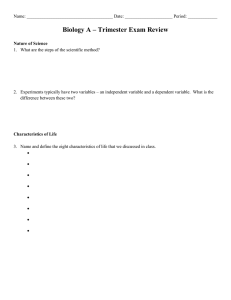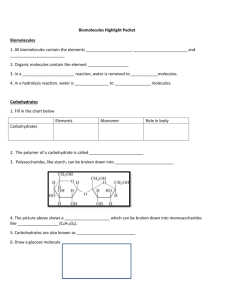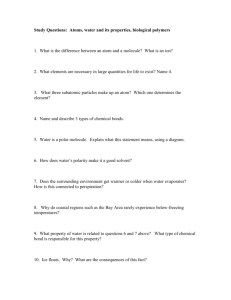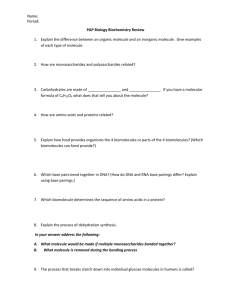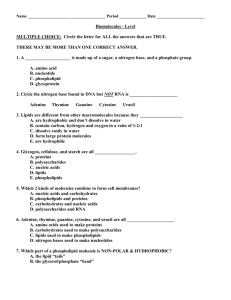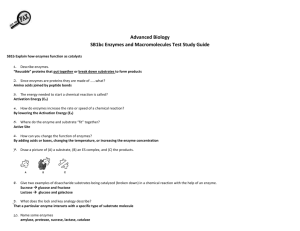Biology A – Trimester Exam Review (Part 2)
advertisement
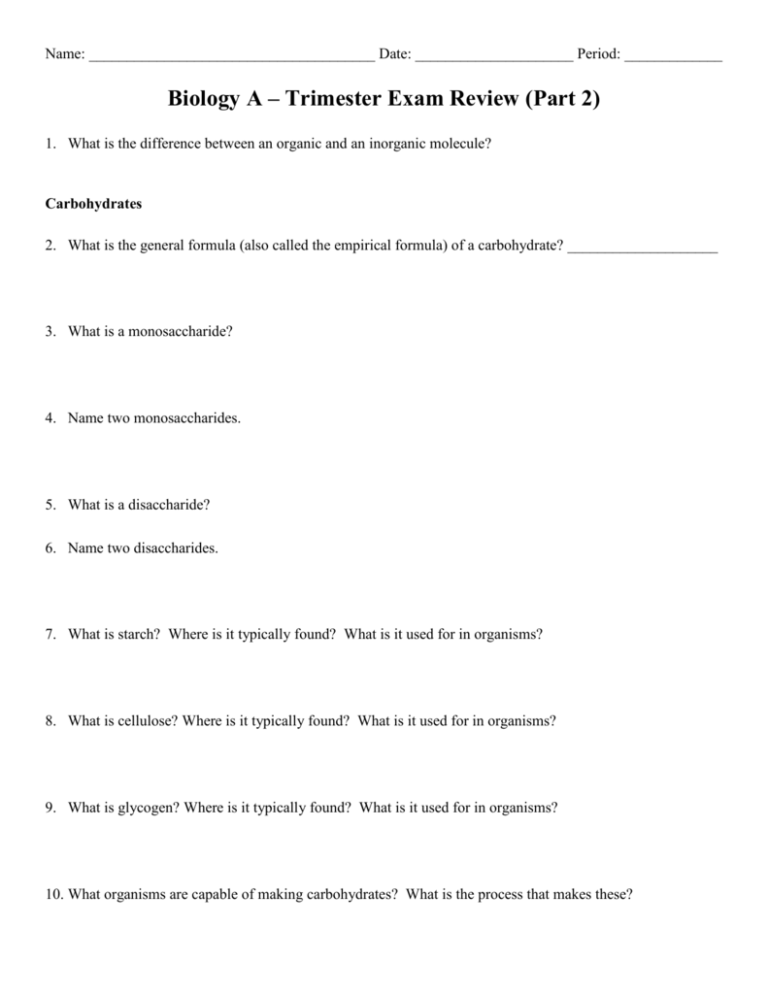
Name: ______________________________________ Date: _____________________ Period: _____________ Biology A – Trimester Exam Review (Part 2) 1. What is the difference between an organic and an inorganic molecule? Carbohydrates 2. What is the general formula (also called the empirical formula) of a carbohydrate? ____________________ 3. What is a monosaccharide? 4. Name two monosaccharides. 5. What is a disaccharide? 6. Name two disaccharides. 7. What is starch? Where is it typically found? What is it used for in organisms? 8. What is cellulose? Where is it typically found? What is it used for in organisms? 9. What is glycogen? Where is it typically found? What is it used for in organisms? 10. What organisms are capable of making carbohydrates? What is the process that makes these? 11. What is a dehydration synthesis reaction? 12. What is a hydrolysis reaction? Lipids 13. What are the six ways that lipids are used by organisms? 14. What are the three classes of lipids? Provide an example for each. 15. What are the characteristics of saturated fat? 16. Provide two examples of a saturated fat. 17. What are the characteristics of unsaturated fat? 18. Provide two examples of an unsaturated fat. 19. Cholesterol is considered both a good and a bad molecule to have in your body. Why? Nucleic Acids 20. What are the two functions of nucleic acids in living organisms? 21. What is the building block (monomer) for nucleic acids? 22. What are the 3 parts of a nucleic acid? 23. Name the two examples of nucleic acids in all organisms. 24. List the different kinds of nitrogen bases in all nucleic acids 25. List the nitrogen bases in DNA. 26. List the nitrogen bases in RNA. 27. Describe the shape of the DNA molecule. 28. Explain why this specific structure of DNA is very important to life on Earth. Proteins 29. List 3 ways that living things use proteins. 30. Give 3 examples of proteins in living organisms. 31. Proteins are chains of what smaller organic molecule? 32. What bond holds these smaller organic molecules together? 33. How many different amino acids are there? _______________________________________ 34. What is meant by the term hydrophobic? _________________________________________ 35. Proteins have four levels of structure. Explain each of the levels. 36. What is it called when a protein unfolds? __________________________________________ 37. Why does unfolding a protein make it not able to do its job in a living organism? Draw that molecule! Complete the table by sketching a picture of each of the following molecules in the column to the right. Molecule Name Monosaccharide Disaccharide Polysaccharide Triglyceride Molecule Picture Phospholipid Saturated Fatty Acid Unsaturated Fatty Acid Nucleotide Amino Acid Enzymes 38. What is an enzyme? 39. What is a substrate? 40. What type of molecule are enzymes? 41. What is the active site of an enzyme? 42. Explain the lock-and-key model of enzyme activity. 43. Explain the induced fit model of enzyme activity. 44. What is activation energy? 45. How is it that enzymes are able to facilitate reactions? 46. The following is an enzyme-facilitated reaction that we worked with in our labs: H2O2 What is/are the reactant(s)? What is/are the substrate(s)? What is the enzyme? catalase H2O + O2 47. What would happen if you boiled the enzyme? 48. What would happen if you froze the enzyme? 49. What would happen if you placed the enzyme in a strong acid? A strong base? Cell Theory 50. Describe the contributions of the following scientists: Leewenhoek Hooke Brown Schleiden Schwann Virchow 51. What are the three parts of the Cell Theory? Cell Structure and Function Directions: For each part of the cell listed, give the function and location within the cell. Then, check the type(s) of cells where this organelle can be found: prokaryote, animal, or plant cell. Eukaryotes Prokaryote Cell Part Function Location (Bacteria) Animal Cell Plant Cell Cell Membrane Cell Wall Chloroplast Cytoplasm Cytoskeleton Endoplasmic Reticulum Golgi Body/Apparatus Lysosome Mitochondria Nuclear Membrane Nucleolus Nucleus Ribosome Vacuole Cellular Transport 52. What is the difference between active and passive transport? 53. Name and define the three types of passive transport. 54. What is a concentration gradient? 55. What is equilibrium? 56. Complete the following table (found in your notes!) If the fluid outside the cell has . . . Then the outside fluid is . . . hypertonic . . . hypotonic . . . isotonic 57. Explain the following two active transport mechanisms: Endocytosis Exocytosis Water diffuses . . . Effect on the cell
